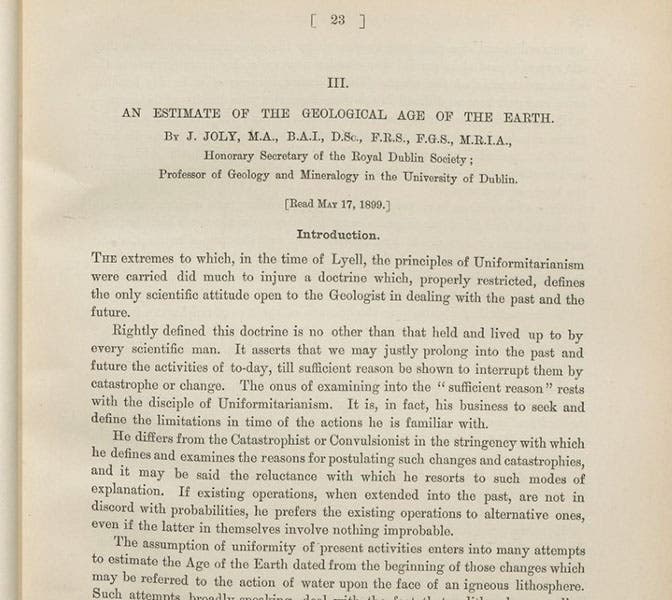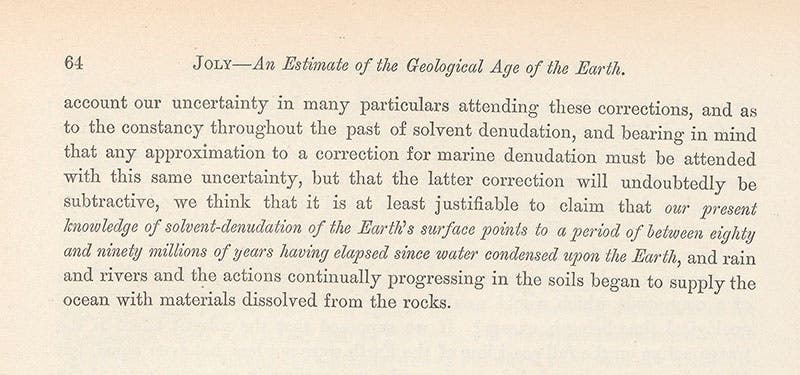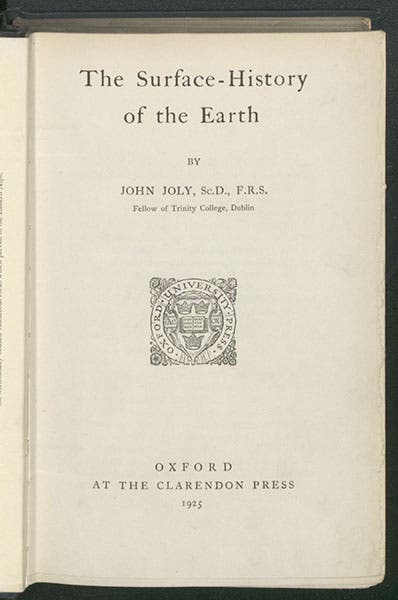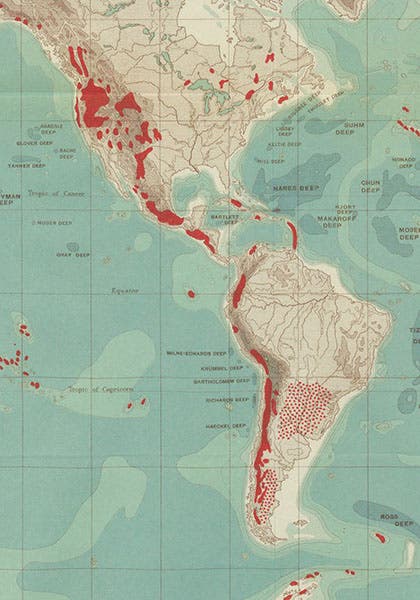Scientist of the Day - John Joly
John Joly, an Irish physical geologist, was born Nov. 1, 1857. Joly studied engineering, physics, geology, and chemistry at Trinity College, Dublin. He stayed on at Trinity as an assistant to the eminent Maxwellian George Francis FitzGgerald, and when in 1897 the position of professor of geology opened up, he was given the post. Joly remained at Trinity College for the rest of his life.
Joly rewarded those who offered him the geology professorship with a bombshell paper in 1898, titled "An estimate of the geological age of the Earth,” read to the Royal Dublin Society and then published in their Scientific Transactions (second image). At that time, there had been two kinds of attempts to calculate the age of the Earth, one a rather vague series of guesses by geologists like Charles Lyell, who used phenomena such as the denudation of the Weald (the slow erosion of a rock formation in southeastern England) to surmise that the Earth was many hundreds of millions of years old. The other was a more precise calculation by the physicist William Thomson (later Lord Kelvin) based on the rate of cooling of the Earth. His estimate of the Earth’s age was somewhere between 24 and 400 million years, with a mean of 100 million years. In 1898, Kelvin was still alive, his calculation was the stuff of textbooks, and his method the only one with any physical and mathematical rigor.
In Joly's 1898 paper, he proposed a new way to calculate the age of the Earth by measuring the salt content of the oceans and determining how long it would take for the erosion of sodium- and potassium-bearing rocks by rivers to raise the saltiness of the ocean from a presumed initial zero to its present concentration. Trying to determine the rate at which the earth's major rivers dump salt into the sea was not easy, but it was doable. Joly determined that the Earth was between 80 and 90 million years old (third image). His figure was in the same ballpark as Kelvin’s calculation, lending credence to a 100-million-year-old Earth, and Joly’s method and result was widely hailed by both geologists and physicists, although it did not please Darwinians or uniformitarian geologists, whose hypotheses really needed a much older Earth.
Joly doesn’t get much applause today for his sea-salt calculations, both because his calculated age for the Earth is short of the correct figure by a factor of 45, and also because it was pointed out in 1910 that Edmond Halley had proposed exactly the same method in 1715, although Halley lacked the data to make any calculations. But a few years later, Joly did something far more impressive. Radioactivity had been discovered by Henri Becquerel in 1896, and radium by the Curies in 1898, and Joly was one of the first to understand that, if the Earth contains an abundance of radioactive materials, which decay and produce heat, then the Earth is not a simple cooling body, but one that generates its own heat. He and Ernest Rutherford were the first to appreciate the importance of radioactivity for geology. Joly published a book in 1909, Radioactivity and Geology, which was quite cutting-edge for its time (fourth image, above). It included a table of the half-lives of various radioactive elements and isotopes and calculations as to how much heat they produce, and what effects the internal heating of the Earth might have on tectonic processes on the surface (fifth image, below). Had he followed up on this, as Arthur Holmes did, he might have realized that the Earth is not millions but billions of years old. But he could never let go of his sea-salt calculations, which he defended to the end, and he never accepted an age for the Earth any older than 300 million years. Instead, he used radioactive heat as a basis for a tectonic theory he called “thermal cycles,” to explain how mountains rose and eroded away. It attracted a few budding geophysicists, but not many, and by 1935, it was dead in the water.
Since Joly believed by 1915 that radioactive heat at intervals melted the “substratum” (his word for the mantle) and allowed landforms to move laterally, he might have been excited by the theory of continental drift, which Alfred Wegener proposed in book form in 1915 and which geologists in the UK more easily encountered in 1924 when Wegener’s book was translated. But although Joly was initially receptive to Wegener’s ideas, by 1925, he seems to have dismissed it, as one can see in his major work, The Surface-History of the Earth (sixth image), where continental drift gets only a brief paragraph at the end.
In spite of the fact that Joly was wrong about nearly everything geological except the importance of radioactive heat, he received honor after honor during his career, and after his death in 1933, his colleagues in Dublin even established the Joly Memorial Lectures, with the first lecture given by none other than Rutherford himself. Joly is still considered one of Ireland’s great geologists. Perhaps he stands out by contrast with the other famous Irishman who determined the age of the Earth, Archbishop James Ussher, who concluded in 1650 that the Earth was created in 4004 B.C.
On an upnote, I thought I would mention that The Surface-History of the Earth does contain a dramatic colored “Oro-Bathygraphical Chart of the World,” which plots the Earth’s major oceanic trenches and ridges, based on the measurements made by John Murray on the Challenger expedition (seventh image). It is quite a precocious map for 1925, and it does not take much hindsight to see tectonic plate boundaries butted up against North and South America and producing the volcanic belts colored red on the map (see detail, eighth image). It is a map that seems worthy of further study.
Dr. William B. Ashworth, Jr., Consultant for the History of Science, Linda Hall Library and Associate Professor emeritus, Department of History, University of Missouri-Kansas City. Comments or corrections are welcome; please direct to ashworthw@umkc.edu.













